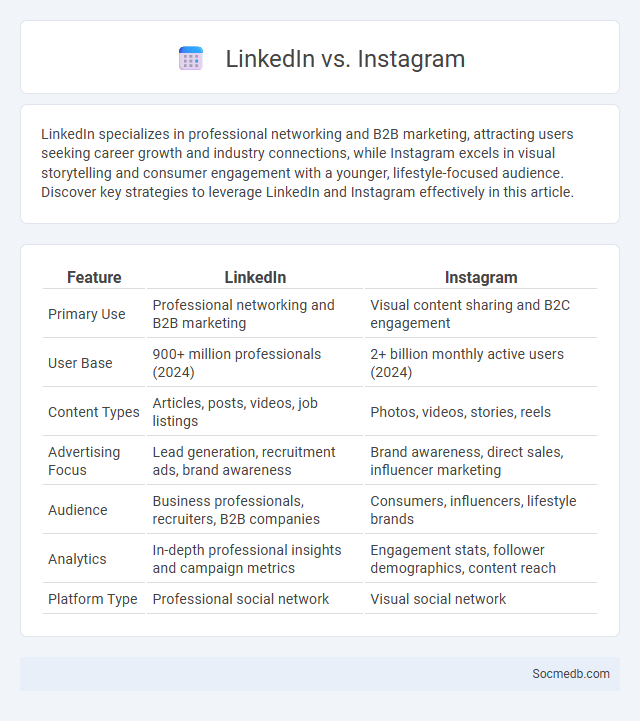
Photo illustration: LinkedIn vs Instagram
LinkedIn specializes in professional networking and B2B marketing, attracting users seeking career growth and industry connections, while Instagram excels in visual storytelling and consumer engagement with a younger, lifestyle-focused audience. Discover key strategies to leverage LinkedIn and Instagram effectively in this article.
Table of Comparison
| Feature | ||
|---|---|---|
| Primary Use | Professional networking and B2B marketing | Visual content sharing and B2C engagement |
| User Base | 900+ million professionals (2024) | 2+ billion monthly active users (2024) |
| Content Types | Articles, posts, videos, job listings | Photos, videos, stories, reels |
| Advertising Focus | Lead generation, recruitment ads, brand awareness | Brand awareness, direct sales, influencer marketing |
| Audience | Business professionals, recruiters, B2B companies | Consumers, influencers, lifestyle brands |
| Analytics | In-depth professional insights and campaign metrics | Engagement stats, follower demographics, content reach |
| Platform Type | Professional social network | Visual social network |
Understanding LinkedIn, Instagram, and Employer Branding
LinkedIn offers powerful tools for professional networking, job searching, and showcasing your expertise, making it essential for building a strong employer brand. Instagram enhances visual storytelling and engagement with your audience, allowing you to highlight your company culture and values through compelling images and videos. Leveraging these platforms effectively helps your business attract top talent and establish a trustworthy reputation in the competitive job market.
Audience Demographics: LinkedIn vs Instagram
LinkedIn's audience primarily consists of professionals aged 25-34, with a strong presence of users in industries such as technology, finance, and marketing, making it ideal for B2B networking and career development. Instagram attracts a younger demographic, predominantly users aged 18-29, with high engagement among lifestyle, fashion, and entertainment enthusiasts, supporting brands focusing on visual storytelling and consumer interaction. Understanding these audience demographics helps marketers tailor content strategies effectively to leverage platform strengths.
Content Strategy for Employer Branding on LinkedIn
Developing a content strategy for employer branding on LinkedIn involves creating authentic, value-driven posts that highlight company culture, employee achievements, and career development opportunities. Leveraging LinkedIn's analytics tools helps identify the most engaging content types and optimal posting times to maximize reach and visibility among target talent pools. Consistent storytelling that aligns with organizational values strengthens employer reputation and attracts skilled professionals seeking meaningful workplace environments.
Visual Storytelling: Leveraging Instagram for Employer Branding
Instagram's visual storytelling capabilities empower companies to showcase authentic workplace culture through images and short videos, enhancing employer branding. By curating employee stories, behind-the-scenes content, and team achievements, brands create emotional connections with potential candidates. High engagement rates on Instagram posts and stories boost brand visibility, attracting top talent in competitive job markets.
Engagement Metrics: Comparing LinkedIn and Instagram
Engagement metrics on LinkedIn primarily focus on professional interactions such as likes, comments, shares, and connection requests, emphasizing quality over quantity with an average engagement rate of 2-3%. Instagram, with its visually-driven platform, boasts higher engagement rates often around 4-6%, driven by likes, comments, story interactions, and saves, ideal for brand visibility and consumer engagement. Analyzing click-through rates and follower growth reveals LinkedIn's strength in B2B marketing, while Instagram excels in B2C campaigns through influencer partnerships and multimedia content.
Employer Brand Messaging Consistency Across Platforms
Maintaining Employer Brand Messaging Consistency Across Platforms is crucial for reinforcing your company's identity and values on social media. Ensuring that Your messaging, tone, and visuals align across LinkedIn, Twitter, Facebook, and Instagram builds trust and recognition among potential candidates and employees. Consistent branding enhances your reputation and attracts talent that resonates with Your company culture.
Attracting Top Talent: Which Platform Delivers Better Results?
LinkedIn outperforms other social media platforms in attracting top talent due to its professional-focused network and advanced recruiting tools, enabling precise targeting of skilled candidates. Platforms like Instagram and Facebook offer broader brand visibility but lack the specialized recruitment features that enhance candidate quality and engagement on LinkedIn. Data from recruiting firms show a 60% higher success rate in filling positions through LinkedIn compared to other social channels.
Case Studies: Successful Employer Branding Campaigns
Employer branding campaigns like Airbnb's #BelongAnywhere showcase how storytelling enhances company culture visibility and attracts top talent. Deloitte's "WorldClass" initiative leverages social media platforms to highlight its commitment to education, boosting employer reputation and engagement. Spotify's "Inside Spotify" campaign uses authentic employee experiences shared on Instagram and LinkedIn, increasing candidate trust and application rates.
Best Practices for Integrating LinkedIn and Instagram Strategies
Maximize your social media impact by leveraging LinkedIn's professional networking strengths alongside Instagram's visual storytelling power, ensuring consistent branding and tailored content for each platform. Use LinkedIn to share industry insights, company updates, and thought leadership, while Instagram should highlight behind-the-scenes moments, product showcases, and engaging visuals to captivate your audience. Coordinating posting schedules, cross-promoting relevant content, and analyzing platform-specific analytics will optimize engagement and reinforce your unique brand message across both channels.
Choosing the Right Platform for Your Employer Branding Goals
Selecting the ideal social media platform for your employer branding depends on your target audience and company values. LinkedIn excels in professional networking and talent acquisition, while Instagram and TikTok offer visual storytelling opportunities to showcase company culture. You should analyze platform demographics and engagement metrics to align your employer branding strategy with channels that maximize reach and authenticity.
 socmedb.com
socmedb.com